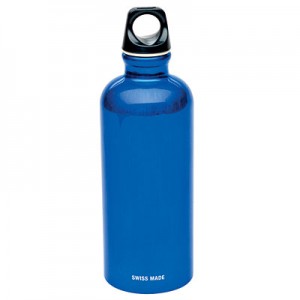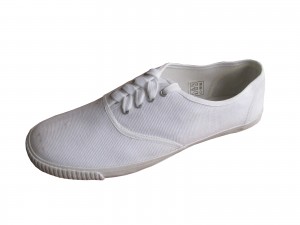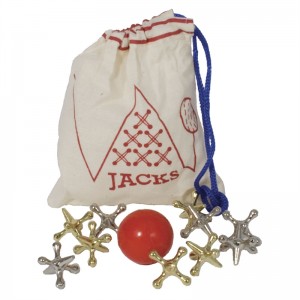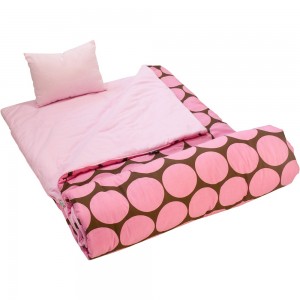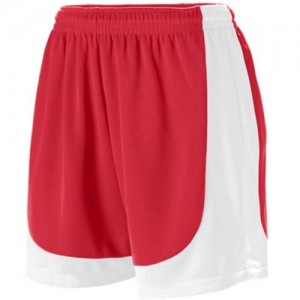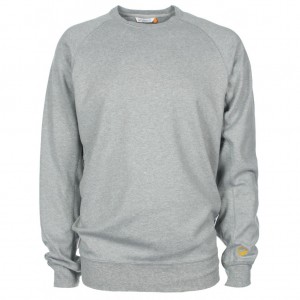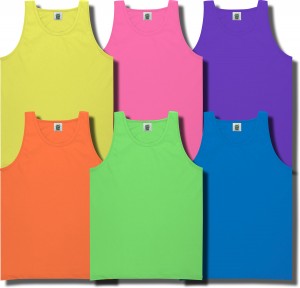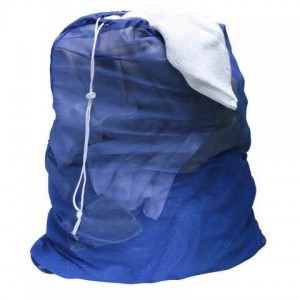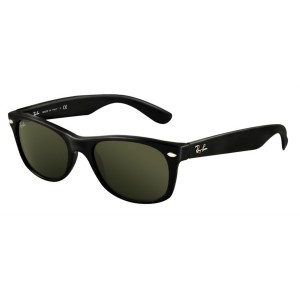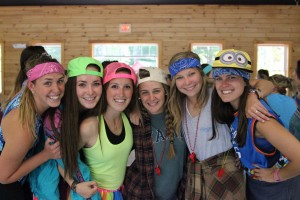 Our Staff Orientation is well underway as we get ready for Camper Arrival this Thursday! We can hardly wait. Camp looks amazing and we’re so excited to see you soon! The new Mastercrafts Pro Stars are set; the Fields are lined; the Courts are ready; the Art Studios are filled with supplies; the brand new Culinary Studio is spectacular; our Ponies and Horses are trained; the Cabins look amazing; the new girls’ cabin, Eastport, is done and looks awesome. All we’re missing now is the most amazing campers anywhere!! Thursday will be here before you know it. We can’t wait to see you soon!
Our Staff Orientation is well underway as we get ready for Camper Arrival this Thursday! We can hardly wait. Camp looks amazing and we’re so excited to see you soon! The new Mastercrafts Pro Stars are set; the Fields are lined; the Courts are ready; the Art Studios are filled with supplies; the brand new Culinary Studio is spectacular; our Ponies and Horses are trained; the Cabins look amazing; the new girls’ cabin, Eastport, is done and looks awesome. All we’re missing now is the most amazing campers anywhere!! Thursday will be here before you know it. We can’t wait to see you soon!
The Official Blog of Laurel South
Moosetrack News
Blog
It’s definitely summer when you know this is about to happen…
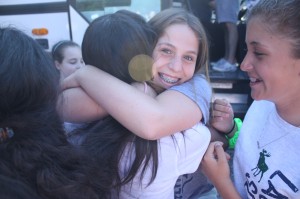 School is FINALLY over! The weather is warm. It’s summer. But as a camper, you know that it’s never REALLY summer until you get to camp, and in just one more week, you’ll be there. The closer arrival day gets, the more you replay what you know is about to happen in your head. There are little signs every year that mark that day to which you’ve been counting down for several LOOOONNNNGGG months. But it’s most definitely summer when you know this is about to happen…
School is FINALLY over! The weather is warm. It’s summer. But as a camper, you know that it’s never REALLY summer until you get to camp, and in just one more week, you’ll be there. The closer arrival day gets, the more you replay what you know is about to happen in your head. There are little signs every year that mark that day to which you’ve been counting down for several LOOOONNNNGGG months. But it’s most definitely summer when you know this is about to happen…
Your parents will take you to a meeting place for a bus or plane ride to camp, or maybe they’re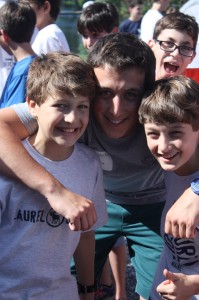 driving you to camp themselves. The trip to camp will seem 10X longer than it actually is because you just want to get there.
driving you to camp themselves. The trip to camp will seem 10X longer than it actually is because you just want to get there.
Your mom will most definitely cry when she says goodbye and assures you she’ll see you on Visiting Day. You’re so excited you can hardly stand it, but maybe you’ll cry a little too just so that she doesn’t feel bad.
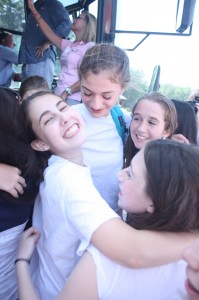 As soon as you pull into camp, you’ll start looking for your camp friends. Maybe they’ll spot you first. No matter who finds whom, you’ll run and hug. After hugs all around with your friends, you’ll also hug your favorite returning counselors and staff members.
As soon as you pull into camp, you’ll start looking for your camp friends. Maybe they’ll spot you first. No matter who finds whom, you’ll run and hug. After hugs all around with your friends, you’ll also hug your favorite returning counselors and staff members.
You’ll meet your cabin mates (if you don’t already know them) and your new counselors, who are every bit as excited as you that you’re finally at camp!
You’ll go into your new cabin with your friends and realize that 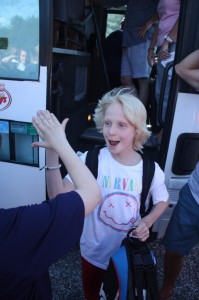 you really ARE at camp. Another summer has begun! Bring on the FUN!
you really ARE at camp. Another summer has begun! Bring on the FUN!
You’ll spend the rest of the day cheering, singing and laughing with your friends. This is just day 1, and the entire summer is ahead of you. But it’s definitely summer because all of this happened, just as you knew it would.
Friendship Bracelets: A Storyboard of Summer
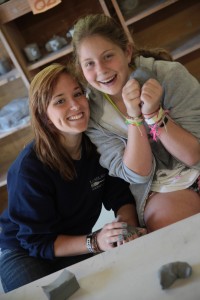 A chuckle-worthy camp confession recently spotted on Pinterest: “My wrists did not see sunlight all summer because of the bracelets.” Anyone who has ever attended or worked at a sleepaway camp is all too familiar with the “bracelet tan.” Of the thousands of camps across America, there is not an Arts & Crafts area that is not well stocked with beads, lanyard, skeins of embroidery floss, paracord, rubber bands and just about anything else that can be turned into a bracelet. Bracelets are BIG at camp. They’re not merely wearable art. They’re a symbol of friendship. Few campers or staff actually keep the bracelets they make for themselves. Instead they exchange them with friends and other special people at camp. Although people have been making friendship bracelets since ancient times, they have become a camp tradition. It’s fun to conjure memories of a special person with a glance at one’s wrist.
A chuckle-worthy camp confession recently spotted on Pinterest: “My wrists did not see sunlight all summer because of the bracelets.” Anyone who has ever attended or worked at a sleepaway camp is all too familiar with the “bracelet tan.” Of the thousands of camps across America, there is not an Arts & Crafts area that is not well stocked with beads, lanyard, skeins of embroidery floss, paracord, rubber bands and just about anything else that can be turned into a bracelet. Bracelets are BIG at camp. They’re not merely wearable art. They’re a symbol of friendship. Few campers or staff actually keep the bracelets they make for themselves. Instead they exchange them with friends and other special people at camp. Although people have been making friendship bracelets since ancient times, they have become a camp tradition. It’s fun to conjure memories of a special person with a glance at one’s wrist.
The act of making the bracelets is almost as pleasurable as the bracelets themselves. Friendship bracelets are also easy to make, and campers of all ages easily catch onto the various ways of braiding and weaving materials into fashionable designs. Friendship bracelets also appeal equally to both boys and girls. The fact that making bracelets takes very little concentration makes them the perfect social craft. It’s easy to interact with others while making bracelets at camp. Bracelet making is the perfect conversation opportunity and bonding activity.
The row of bracelets is not just camp fashion, it’s a storyboard of the summer that is unique to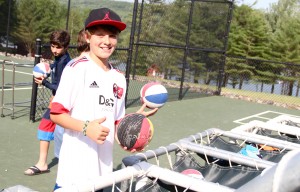 every individual at camp. It represents who they met during the summer and the special moments that have been committed to memory. One the best things about friendship bracelets is finding them tucked away long after the summer has ended, and having a moment to remember the summer and the people and stories behind each bracelet.
every individual at camp. It represents who they met during the summer and the special moments that have been committed to memory. One the best things about friendship bracelets is finding them tucked away long after the summer has ended, and having a moment to remember the summer and the people and stories behind each bracelet.
How to Have Fun at Summer Camp
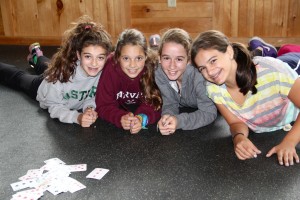 Campers: June is finally here and you’re about to head off to camp for the summer. Whether this is your first summer or your seventh, it’s completely normal to be a whole lot excited and even a little bit nervous. This just HAS to be the best summer EVER…as in epic! But do you ever find yourself a little bit confused about how to make that happen? Here are a few ideas to help you out as you get ready for camp.
Campers: June is finally here and you’re about to head off to camp for the summer. Whether this is your first summer or your seventh, it’s completely normal to be a whole lot excited and even a little bit nervous. This just HAS to be the best summer EVER…as in epic! But do you ever find yourself a little bit confused about how to make that happen? Here are a few ideas to help you out as you get ready for camp.
Make new friends
Of course your old friends are amazing. That’s why they’re your friends. But new friends are pretty great too. Make it a point to say ‘hello’ to people and introduce yourself to those you don’t know. Talk to other campers to find out what you have in common besides camp. Show support for other campers at activities.
Get involved in camp activities
There are so many awesome things to do at camp. Take advantage of the opportunity to get involved in them. Don’t just rely on 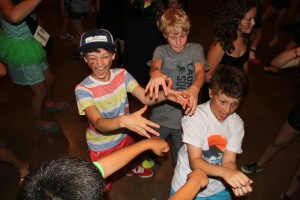 favorites for your summer fun. Try some new things too. You’ll find that if you go to each activity—even those you don’t love—with a positive attitude and get involved, camp is even more fun.
favorites for your summer fun. Try some new things too. You’ll find that if you go to each activity—even those you don’t love—with a positive attitude and get involved, camp is even more fun.
Show your camp spirit
Camps rely on their campers to create a fun, energetic environment by showing their camp spirit. There’s a reason you count down the months and days each year until it’s time for camp and why YOUR camp is the BEST camp. Don’t be shy about showing it at camp.
Be your best self
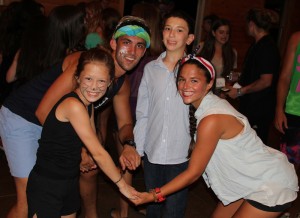 Camp is the most fun for everyone when campers are positive, energetic, open and inclusive. There’s no need to make it like school where only certain types of people hang around together. If someone in your bunk or at your activity is shy, go out of your way to include them and take a leadership role in introducing them to others. If your friends try to say negative things about other people, change the subject or reply with a positive. Encourage others at activities, particularly those who struggle or who fear being made fun of. The more fun that everyone has together, the better camp is!
Camp is the most fun for everyone when campers are positive, energetic, open and inclusive. There’s no need to make it like school where only certain types of people hang around together. If someone in your bunk or at your activity is shy, go out of your way to include them and take a leadership role in introducing them to others. If your friends try to say negative things about other people, change the subject or reply with a positive. Encourage others at activities, particularly those who struggle or who fear being made fun of. The more fun that everyone has together, the better camp is!
Keep an open mind
Sometimes, things at summer camp don’t go quite how you expected. Think before you react. Don’t let one bad activity, conversation or even day ruin your whole summer. Remember, it’s just one thing out of thousands that happen over the summer. Rather than dwelling on that one thing, shake it off and move on. If you do, you probably won’t even remember it by the end of the summer.
Counselors, It’s Time to Pack!
You’ve scored an amazing summer job at a sleepaway camp and the summer is so close that you can practically taste the s’mores, smell the camp air and hear your campers laughing. But before you can head off for the summer of your life, you have to pack. Packing can be a daunting task for first time camp staff. Even if your camp supplies a packing list, it’s hard to determine what you may be able to leave behind, if packing space is at a premium, and what you absolutely must have. Here is a brief rundown of those items that camp staff traditionally believe are essential.
If you pack these items, you are in good shape….
Sunscreen
You’re working at a summer camp, and “outdoors” is an operative word in your upcoming summer. In fact, you’ll spend the majority of your day outside. Applying sunscreen often and generously insures that you do not find yourself very red and uncomfortable at the end of a sunny day and protects your skin from the potential long term effects of the sun’s rays.
Water bottle
Heat plus a lot of activity equals the need to stay hydrated. Whether or not your camp provides water, it’s a good idea to take a water bottle that can be refilled several times throughout the day. It’s also environmentally friendly by reducing the use of disposable cups.
Several pairs of shoes for all types of weather
Athletic shoes are essential. Multiple pairs, if you have them, are ideal. Most traditional sports oriented camps do not allow staff to wear flip-flops or open toed shoes for activities that are not water related. It’s simply unsafe in an athletic environment. So one or two pairs for water-related activities and days off are sufficient. A pair of rain boots or galoshes is always a good idea.
Bunk/Cabin games (Jacks, puzzle games, etc.)
These activities help facilitate communication with campers, and are so much fun while in the bunk or cabin during resting periods or rainy days. Some items are not allowed in bunks or cabins, however, so be sure you check with your camp to make sure that games and other activity items are permitted.
Bedding
Some camps provide bedding. Other camps require staff members to bring their own bedding. If your camp requires you to bring bedding, it is a good idea to bring a thick blanket or comforter in addition to a thin one. Yes, it’s summer. But most camps are in rural mountainous regions, and it sometimes gets cool at night, especially at the very beginning and toward the end of the summer.
Lots of socks and under garments
A saying is among camp staff who return year after year, you can never have too many of either!
Comfortable shorts/pants
Athletic type shorts and pants are best for moving through daily activities, but it ultimately comes down to whatever you feel the most comfortable wearing.
A couple of sweatshirts or sweaters
Again, yes it’s summer, but the evenings can get a bit chilly.
Some colorful shirts and shorts (especially in your camp’s colors)
Camps often divide staff and campers into teams for activities by colors. So it’s a good idea to pack a rainbow of colors so that you are prepared to show team spirit when the time comes.
A few plain white t-shirts/tanks that can be dyed or altered for costume purposes…
You just never know at summer camp.
A bag for laundry
Eventually, you’re going to need to do your laundry at camp. It helps to have a laundry bag for easy transport to and from the laundry. (Many camps provide laundry bags- so check first.)
Sunglasses
A couple of pairs are a good idea. There is a lot of movement at camp, and sunglasses are an item that is commonly lost, forgotten or broken.
Equipment
Ask yourself, what will you be doing at camp? Will you need some type of special equipment that you need to bring. If so, make sure you leave room for it when you are packing.
Toiletries
Most camps are within a reasonable distance to a shop from which these types of items can easily be replenished. So you usually only need enough of these to last the first couple of weeks, if packing space is at a premium.
If you stuff your suitcase or duffle with these items, you’ll be in good shape for your first summer at camp. If you’re concerned that you don’t have room in your luggage for all of these items, call your camp to see if staff members are permitted to ship items to camp.
Environmentally Friendly Noise
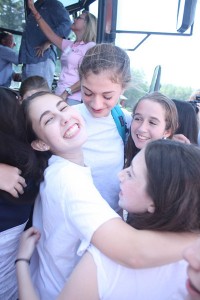 Whether you’re a new or returning staff member who is preparing to work at camp this summer, the decibel level of those first few days at camp are always a bit above what you anticipate. Of course, we hear noise every day. But camp noise is different than other noise. A camp staff member once relayed a memory of her first summer at camp. She recalled the shock of the day the campers arrived. ‘It was suddenly very loud,’ she said. ‘They don’t prepare you for that at orientation. Then again, there is probably no way they could.’ She is right. There is no way to describe what several hundred excited children who have been waiting for a moment for ten months sounds like. It’s certainly not noise pollution, though. It much more closely resembles environmentally friendly noise. It’s the noise of excitement, happiness and anticipation.
Whether you’re a new or returning staff member who is preparing to work at camp this summer, the decibel level of those first few days at camp are always a bit above what you anticipate. Of course, we hear noise every day. But camp noise is different than other noise. A camp staff member once relayed a memory of her first summer at camp. She recalled the shock of the day the campers arrived. ‘It was suddenly very loud,’ she said. ‘They don’t prepare you for that at orientation. Then again, there is probably no way they could.’ She is right. There is no way to describe what several hundred excited children who have been waiting for a moment for ten months sounds like. It’s certainly not noise pollution, though. It much more closely resembles environmentally friendly noise. It’s the noise of excitement, happiness and anticipation.
A strange phenomenon happens with environmentally friendly noise. You not only expect it, but anticipate hearing it every day. You don’t even realize how much you look forward to camp noise until the end of camp. When the buses pull away on the last day of camp, the quietness that settles over the campus is one of the saddest moments of the summer. You realize the kids are gone, and the summer really is over. Even after you return home, you find yourself wishing to hear the sounds that defined your summer–bugle calls or bells to signal daily activities, constant cheering and laughter, mealtimes with hundreds of other people. Everyday noise just seems like noise pollution.
Camp Trips
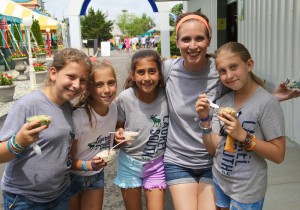 Campers love their camps. They’re green, picturesque and they often feature facilities for just about any activity a kid can dream up. One thing campers also love, however, are camp trips. Camp trips are a lot like school field trips — only better. Way better! They’re a special time away from the daily routine. Campers get to board buses with their friends and go off on an adventure outside of the camp environment. Yes, playing by the camp waterfront with friends is a great way to spend a summer. But taking in a baseball game, visiting a local amusement park, or going bowling with them adds an extra element to the camp experience because it allows campers to do normal “friend things” with some very close friends who they often only get to see during the summer.
Campers love their camps. They’re green, picturesque and they often feature facilities for just about any activity a kid can dream up. One thing campers also love, however, are camp trips. Camp trips are a lot like school field trips — only better. Way better! They’re a special time away from the daily routine. Campers get to board buses with their friends and go off on an adventure outside of the camp environment. Yes, playing by the camp waterfront with friends is a great way to spend a summer. But taking in a baseball game, visiting a local amusement park, or going bowling with them adds an extra element to the camp experience because it allows campers to do normal “friend things” with some very close friends who they often only get to see during the summer.
Rites of passage are a big part of camp and trips are among those rites. While all 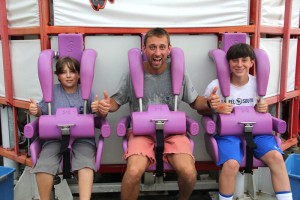 campers enjoy some of the same trip destinations throughout the summer, other places are reserved for campers of certain ages. In this respect, trips become a way for campers to mark time in their camp experience. An exclusive trip makes that specific summer unique because it’s the only summer a camper may go to a specific place.
campers enjoy some of the same trip destinations throughout the summer, other places are reserved for campers of certain ages. In this respect, trips become a way for campers to mark time in their camp experience. An exclusive trip makes that specific summer unique because it’s the only summer a camper may go to a specific place.
Camp trips also help campers put their summer camp experience into perspective. Sure, they could do just about anything they do on a camp trip without having gone to camp, but doing them at camp makes them part of camp. And makes them very special. And very fun! The memory of having done those things at camp makes these excursions even more special, which is likely why there is always a tinge of excitement in the air on trip day.
Sunset at Camp
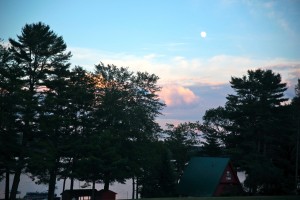 Camp provides the perfect backdrop to a sunset. Watching the sun dip below the tree line and catch the reflection of the water before finally disappearing into the horizon as the campus slowly lights up isn’t just a classic picturesque image of camp, it’s symbolic. It signals a shift in the camp day. The daily activities have ended and now it’s time for the evening to begin.
Camp provides the perfect backdrop to a sunset. Watching the sun dip below the tree line and catch the reflection of the water before finally disappearing into the horizon as the campus slowly lights up isn’t just a classic picturesque image of camp, it’s symbolic. It signals a shift in the camp day. The daily activities have ended and now it’s time for the evening to begin.
Sunset at camp signifies dinner. Dinner is an important activity at summer camp. It’s a time for everyone to come together and tell stories about their day as they share a meal as the daylight slowly transitions into a star filled night.
With the sunset also comes campfires. Each camp has its own unique campfire 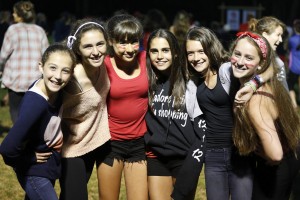 traditions. But the one thing they all have in common is that campfires happen after the sun goes down. Whether it’s entertaining each other, singing songs or eating s’mores, sitting around a campfire at night helps everyone tune into the environment around them and take in the magic of summer camp. The sounds of campus become more amplified. The smells become more distinct.
traditions. But the one thing they all have in common is that campfires happen after the sun goes down. Whether it’s entertaining each other, singing songs or eating s’mores, sitting around a campfire at night helps everyone tune into the environment around them and take in the magic of summer camp. The sounds of campus become more amplified. The smells become more distinct.
Campers and staff alike also know when they see the sun begin to set that it’s almost time for evening activities. Evening activities are some of the most action-packed and anticipated moments at camp. Sometimes the entire camp participates in evening activities together while at others separate activities are held for different age groups.
 It’s so easy to not even notice the sunset during the ten months when one is not at summer camp. But at camp, sunset is something that just can’t be missed. Not only is it an important part of the camp day, it’s nice to take notice of such a beautiful transition and to understand that taking notice of it is a special part of camp.
It’s so easy to not even notice the sunset during the ten months when one is not at summer camp. But at camp, sunset is something that just can’t be missed. Not only is it an important part of the camp day, it’s nice to take notice of such a beautiful transition and to understand that taking notice of it is a special part of camp.
Adventure Abound
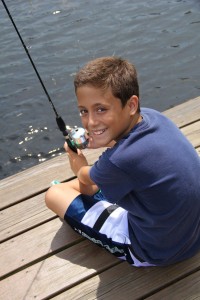 The outdoors and adventure are both synonymous with camp, so it’s no wonder that some of the most popular activities at camp involve outdoor adventure. Summer camp outdoor adventure programs of today have transcended the traditional nature walk (although those still occasionally happen). Outdoor adventure at camp truly incorporates “adventure” into the activities. Campers have the opportunity to scale 50 foot walls or fly over camp on a zip line. They maneuver their way across high and low ropes courses. Using GPS trackers, they locate objects hidden throughout camp. On sunny days, they hike through the woods while enjoying waterfalls, mountain views and absorbing the scents of leaves, trees, and grass. They learn valuable outdoor living skills.
The outdoors and adventure are both synonymous with camp, so it’s no wonder that some of the most popular activities at camp involve outdoor adventure. Summer camp outdoor adventure programs of today have transcended the traditional nature walk (although those still occasionally happen). Outdoor adventure at camp truly incorporates “adventure” into the activities. Campers have the opportunity to scale 50 foot walls or fly over camp on a zip line. They maneuver their way across high and low ropes courses. Using GPS trackers, they locate objects hidden throughout camp. On sunny days, they hike through the woods while enjoying waterfalls, mountain views and absorbing the scents of leaves, trees, and grass. They learn valuable outdoor living skills.
Adventure is defined as an “exciting or unusual activity.” Certainly, for most campers, there is very 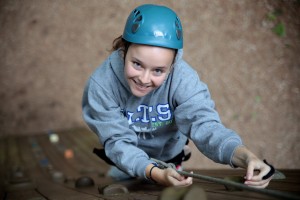 little that is mundane about standing at the top of a 25 foot platform preparing to take a leap of faith. For that matter, even the traditional hike through the woods is less than ordinary for the majority of children today. Campers frequently report feeling “refreshed” or “invigorated” following outdoor adventure activities. A study conducted by the Children & Nature Network suggests those aren’t just adjectives.
little that is mundane about standing at the top of a 25 foot platform preparing to take a leap of faith. For that matter, even the traditional hike through the woods is less than ordinary for the majority of children today. Campers frequently report feeling “refreshed” or “invigorated” following outdoor adventure activities. A study conducted by the Children & Nature Network suggests those aren’t just adjectives.
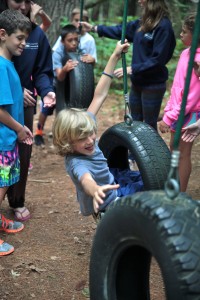 Children who spend time in close proximity to the outdoors tend to feel more energetic than children who spend large amounts of time indoors. They’re also less stressed and anxious. That’s because fresh air literally has a calming effect. Another study conducted by The National Recreation and Park Association concluded that, simply put, our brains need oxygen. Oxygen promotes a healthy psychology as well as helps children relax and even improves their immune systems. There is also data to suggest that exposure to the outdoors has a positive effect on attention deficit and hyperactivity disorders. The study concurs with that conducted by the Children & Nature Network; there is a reason parks were built in urban areas to promote good health. They do just that.
Children who spend time in close proximity to the outdoors tend to feel more energetic than children who spend large amounts of time indoors. They’re also less stressed and anxious. That’s because fresh air literally has a calming effect. Another study conducted by The National Recreation and Park Association concluded that, simply put, our brains need oxygen. Oxygen promotes a healthy psychology as well as helps children relax and even improves their immune systems. There is also data to suggest that exposure to the outdoors has a positive effect on attention deficit and hyperactivity disorders. The study concurs with that conducted by the Children & Nature Network; there is a reason parks were built in urban areas to promote good health. They do just that.
Outdoor adventure activities at summer camp provide campers with the opportunity to immerse themselves in the outdoors through exciting mediums that aren’t available to them at home. Although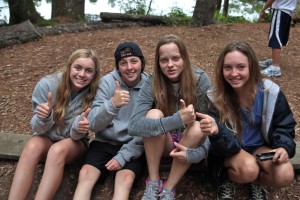 climbing walls and even zip lines are being constructed by many suburban recreational centers, a good number of them are indoors. Engaging in adventurous activities outdoors reaches beyond mental and physical health benefits. It helps campers develop an appreciation for the natural environment and a distinct awareness of what separates artificial environments from nature. Sure, several outdoor adventure activities can be recreated indoors, but the sights, sounds, and smells that campers learn to associate with them cannot.
climbing walls and even zip lines are being constructed by many suburban recreational centers, a good number of them are indoors. Engaging in adventurous activities outdoors reaches beyond mental and physical health benefits. It helps campers develop an appreciation for the natural environment and a distinct awareness of what separates artificial environments from nature. Sure, several outdoor adventure activities can be recreated indoors, but the sights, sounds, and smells that campers learn to associate with them cannot.
Not Your Mom and Dad’s Arts and Crafts
 Summer camp arts and crafts programs often conjure images of beading lanyards and tie dying. Indeed, crafts are still a large part of camp, but art is becoming equally as important. That is to say that camps are investing more in open ended mediums that encourage campers to use their creativity to create works of their volition as opposed to pre-determined projects of summer camps past.
Summer camp arts and crafts programs often conjure images of beading lanyards and tie dying. Indeed, crafts are still a large part of camp, but art is becoming equally as important. That is to say that camps are investing more in open ended mediums that encourage campers to use their creativity to create works of their volition as opposed to pre-determined projects of summer camps past.
The difference between art and crafts may not be immediately clear to those who envision a room at summer camp that houses a seemingly unlimited supply of paintbrushes, glitter, paint, markers, glue, construction paper, and beads. There is a marked difference, however. A recent article featured in Early Childhood News, M.A. and creative arts instructor Anna Reyer outlines the distinctions between art and crafts. Primarily art is open ended creations that evolve from a variety of supplies and minimal guidance. Crafts are pre-scripted projects assembled using specific supplies and guidelines with a finished product that is the same or similar for everyone. There is something to be said for both the “arts” and the “crafts” of arts and crafts.
Crafts are fun, and many a camper sings the praises of the relaxation and satisfaction derived from a few minutes of down time in which they are given a set of materials and a set of instructions and are left to their own devices. It is an opportunity to be social and engage in casual conversation with other campers and counselors. There is also a sense of satisfaction with the end product, a three-dimensional completed object that the camper created from a group of raw materials.
Then there is art, the benefits of which are becoming increasingly obvious to camp owners and directors. Art projects provide 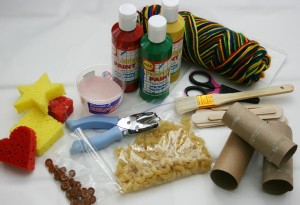 campers with a period of time during the day in which very little, if anything, has been planned for them. It is their time to create as they choose. Whether it is painting or creating a piece of jewelry, it is a sanctioned part of the day that is limited only by their imaginations. Camp in general is a creative space. Through art, it is also an imaginative space. It’s a space in which children are free to unwind and mentally process their feelings. Art is the perfect opportunity for campers to recharge and turn around a day that has been less than perfect. In that regard, similar things could be said about camp music, theater, and dance programs.
campers with a period of time during the day in which very little, if anything, has been planned for them. It is their time to create as they choose. Whether it is painting or creating a piece of jewelry, it is a sanctioned part of the day that is limited only by their imaginations. Camp in general is a creative space. Through art, it is also an imaginative space. It’s a space in which children are free to unwind and mentally process their feelings. Art is the perfect opportunity for campers to recharge and turn around a day that has been less than perfect. In that regard, similar things could be said about camp music, theater, and dance programs.
With the importance placed on creativity, fun, and happiness at summer camp, it is natural that summer camps invest big in arts and crafts programs. A memorable summer is more than just the glory of scoring a winning goal or swimming in the lake. Those times in which campers are left to their creative devices and are free to interact or not interact as they please provide crucial balance to the rest of the summer camp experience.



